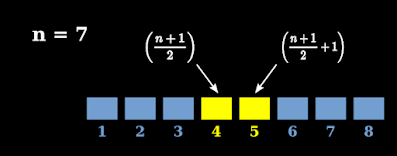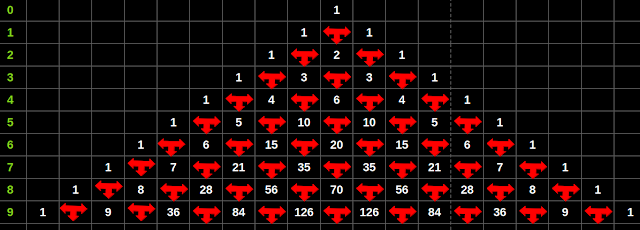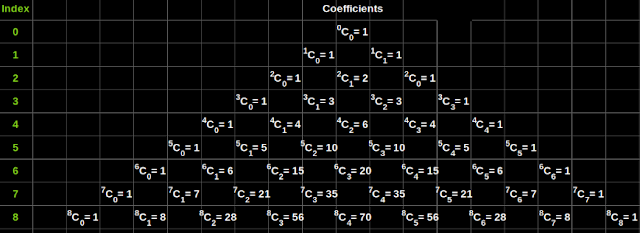In the previous section, we saw General and Middle terms in binomial expansions. We saw a solved example also. In this section, we will see a few more solved examples.
Solved example 8.6
Show
that the middle term in the expansion of $(1+x)^{2n}$ is $\frac{1 × 3 ×
5~.~.~.~(2n-1)}{n!} 2n x^n$, where n is a positive integer.
Solution:
1. Given that, n is a +ve integer. So 2n will be an even number.
2. Since the index is 2n, there will be an odd number (2n+1) of terms.
3. We have seen that, if the number of terms is odd, there will be an unique middle term.
• It's position is given by: $\frac{2n}{2}+1~=~(n+1)$
4. Now consider the expansion of $(1+x)^{2n}$
• We want to find the middle term, which is the (n+1)th term.
• We know that, the (r+1)th term of the binomial expansion (a+b)n is given by: nCr an-r br
5. In our present case, a = 1, b = x and n = 2n.
So the middle term, which is the (n+1)th term will be:
${}^{2n} {\rm{C}}_n\;1^{2n-n}\;x^n$
$\begin{array}{ll}
{}={}&{}^{2n} {\rm{C}}_n\; × 1 × x^n&{}& {} &{} \\
{}={}&\frac{2n! × x^n}{n!(2n-n)!}&{}& {} &{} \\
{}={}&\frac{2n! × x^n}{n! n!}&{}& {} &{} \\
{}={}&\frac{2n(2n-1)(2n-2)~.~.~.~4 × 3 × 2 × 1 × x^n}{n! n!}&{}& {} &{} \\
{}={}&\frac{1 × 2 × 3 × 4~.~.~.~(2n-2)(2n-1)2n× x^n}{n! n!}&{}& {} &{} \\
{}={}&\frac{1 × 2 × 3 × 4~.~.~.~(2n-1)2n× x^n}{n! n!}&{}& {} &{} \\
{}={}&\frac{[1 × 3 × 5 × ~.~.~.~ ×(2n-1)] [2 × 4 × 6 × ~.~.~.~ × 2n]× x^n}{n! n!}&{}& {} &{} \\
{}={}&\frac{[1
× 3 × 5 × ~.~.~.~ ×(2n-1)] [(2 × 1) × (2 × 2) × (2 × 3) × ~.~.~.~ × (2 ×
n)]× x^n}{n! n!}&{}& {} &{} \\
{}={}&\frac{[1 × 3 × 5 × ~.~.~.~ ×(2n-1)] 2^n[1 × 2 × 3 × ~.~.~.~ × n]× x^n}{n! n!}&{}& {} &{} \\
{}={}&\frac{[1 × 3 × 5 × ~.~.~.~ ×(2n-1)] 2^n[n!]× x^n}{n! n!}&{}& {} &{} \\
{}={}&\frac{[1 × 3 × 5 × ~.~.~.~ ×(2n-1)] 2^n× x^n}{n!}&{}& {} &{} \\
\end{array}$
Solved example 8.7
Find the coefficient of x6y3 in the expansion of (x+2y)9
Solution:
1. Assume that x6y3 occurs in the (r+1)th term.
• We know that, the (r+1)th term of the binomial expansion (a+b)n is given by: nCr an-r br
• In our present case, n = 9, a = x and b = 2y
2. So we can write:
(r+1)th term of the expansion of (x+2y)9 = 9Cr x9-r (2y)r
= 9Cr x9-r 2r yr = [9Cr × 2r][x9-r × yr]
• Thus we get:
♦ Constant part (coefficient) of the (r+1)th term = [9Cr × 2r]
♦ Variable part of the (r+1)th term = [x9-r × yr]
3. But given that, the variable part is x6y3
Comparing this with [x9-r × yr], we get: r = 3
4. So the coefficient = [9Cr × 2r] = [9C3 × 23] = 672
Solved example 8.8
The second, third and fourth terms in the binomial expansion (x + a)n are
240, 720 and 1080, respectively. Find x, a and n.
Solution:
1. We know that, the (r+1)th term of the binomial expansion (a+b)n is given by: nCr an-r br
• In our present case, a = x and b = a
2. For the second term, r = 1
So we get: T2 = nC1 xn-1 a1 = 240
3. For the third term, r = 2
So we get: T3 = nC2 xn-2 a2 = 720
4. For the fourth term, r = 3
So we get: T4 = nC3 xn-3 a3 = 1080
5. Dividing (3) by (2), we get:
$\begin{array}{ll}
{\frac{T_3}{T_2}}&{}={}
&\frac{{}^{n} {\rm{C}}_2 × x^{n-2} × a^2}{{}^{n} {\rm{C}}_1 × x^{n-1} × a^1}& {}={}
&\frac{720}{240}& {}
&{}& {}
&{}& {}&{}& {} &{} \\
{}&{}={}
&{\frac{{}^{n} {\rm{C}}_2 × x^n × x^{-2} × a^2}{{}^{n} {\rm{C}}_1 × x^n × x^{-1} × a^1}}& {}={}
&3& {}
&{}& {}
&{}& {}&{}& {} &{} \\
{}&{}={}
&{\frac{{}^{n} {\rm{C}}_2 × x^{-1} × a}{{}^{n} {\rm{C}}_1 }}& {}={}
&3& {}
&{}& {}
&{}& {}&{}& {} &{} \\
{}&{}={}
&{\frac{\frac{n!}{2!(n-2)!} × x^{-1} × a}{\frac{n!}{1!(n-1)!} }}& {}={}
&3& {}
&{}& {}
&{}& {}&{}& {} &{} \\
{}&{}={}
&{\frac{1!(n-1)! × x^{-1} × a}{2!(n-2)! }}& {}={}
&3& {}
&{}& {}
&{}& {}&{}& {} &{} \\
{}&{}={}
&{\frac{(n-1)(n-2)! × x^{-1} × a}{2 × (n-2)! }}& {}={}
&3& {}
&{}& {}
&{}& {}&{}& {} &{} \\
{}&{}={}
&{\frac{(n-1) × x^{-1} × a}{2}}& {}={}
&3& {}
&{}& {}
&{}& {}&{}& {} &{} \\
{}&{}={}
&{\frac{(n-1)}{2}~ × ~\frac{a}{x}}& {}={}
&3& {}
&{}& {}
&{}& {}&{}& {} &{} \\
\end{array}$
$\Rightarrow~\frac{a}{x}~=~\frac{6}{(n-1)}$
6. Dividing (4) by (3), we get:
$\begin{array}{ll}
{\frac{T_4}{T_3}}&{}={}
&\frac{{}^{n} {\rm{C}}_3 × x^{n-3} × a^3}{{}^{n} {\rm{C}}_2 × x^{n-2} × a^2}& {}={}
&\frac{1080}{720}& {}
&{}& {}
&{}& {}&{}& {} &{} \\
{}&{}={}
&{\frac{{}^{n} {\rm{C}}_3 × x^n × x^{-3} × a^3}{{}^{n} {\rm{C}}_2 × x^n × x^{-2} × a^2}}& {}={}
&1.5& {}
&{}& {}
&{}& {}&{}& {} &{} \\
{}&{}={}
&{\frac{{}^{n} {\rm{C}}_3 × x^{-1} × a}{{}^{n} {\rm{C}}_2 }}& {}={}
&1.5& {}
&{}& {}
&{}& {}&{}& {} &{} \\
{}&{}={}
&{\frac{\frac{n!}{3!(n-3)!} × x^{-1} × a}{\frac{n!}{2!(n-2)!} }}& {}={}
&1.5& {}
&{}& {}
&{}& {}&{}& {} &{} \\
{}&{}={}
&{\frac{2!(n-2)! × x^{-1} × a}{3!(n-3)! }}& {}={}
&1.5& {}
&{}& {}
&{}& {}&{}& {} &{} \\
{}&{}={}
&{\frac{2! × (n-2)(n-3)! × x^{-1} × a}{3 × 2! × (n-3)! }}& {}={}
&1.5& {}
&{}& {}
&{}& {}&{}& {} &{} \\
{}&{}={}
&{\frac{(n-2) × x^{-1} × a}{3}}& {}={}
&1.5& {}
&{}& {}
&{}& {}&{}& {} &{} \\
{}&{}={}
&{\frac{(n-2)}{3}~ × ~\frac{a}{x}}& {}={}
&1.5& {}
&{}& {}
&{}& {}&{}& {} &{} \\
\end{array}$
$\Rightarrow~\frac{a}{x}~=~\frac{4.5}{(n-2)}$
7. Equating the results in (5) and (6), we get:
$\frac{a}{x}~=~\frac{6}{(n-1)}~=~\frac{4.5}{n-2}$
$\Rightarrow~6n-12~=~4.5n-4.5$
$\Rightarrow~ 1.5n~=~7.5$
$\Rightarrow~ n ~=~5$
8. Substituting the value of n in (5), we get:
$\frac{a}{x}~=~\frac{6}{5-1}~=~\frac{6}{4}~=~1.5$
$\Rightarrow~a~=~1.5x$
9. Substituting the value of n in (2), we get:
5C1 x5-1 a1 = 240
⇒ 5 × x4× a = 240
• Substituting for a using (8), we get:
5 × x4 × 1.5x = 240
⇒ 7.5x5 = 240
⇒ x = 2
10. Substituting for x in (8), we get:
a = 1.5 × 2 = 3
Solved example 8.9
The coefficients of three consecutive terms in the expansion of (1 + a)n are in the ratio 1: 7 : 42. Find n.
Solution:
1. Let the three consecutive terms be (r+1)th, (r+2)th and (r+3)th
2. The general term is given by: Tr+1 = nCr an-r br
• In our present case, a = 1 and b = a
3. The first of the three consecutive terms will be: nCr+1 1n-1 ar+1 = nCr+1 ar+1
So the coefficient of this first term will be nCr+1
4. The second of the three consecutive terms will be: nCr+2 1n-2 ar+2 = nCr+2 ar+2
So the coefficient of this second term will be nCr+2
5. The third of the three consecutive terms will be: nCr+3 1n-3 ar+3 = nCr+3 ar+3
So the coefficient of this third term will be nCr+3
6. We are given the ratio between the coefficients. So we can write:
nCr+1 : nCr+2 : nCr+3 = 1 : 7 : 42
7. Consider the ratio of second coefficient to first coefficient. We get:
$\frac{{}^{n} {\rm{C}}_{r+2}}{{}^{n} {\rm{C}}_{r+1}}~=~7$
$\Rightarrow~\frac{\frac{n!}{(r+2)![n-(r+2)]!}}{\frac{n!}{(r+1)![n-(r+1)]!}}~=~7$
$\Rightarrow~\frac{(r+1)![n-(r+1)]!}{(r+2)![n-(r+2)]!}~=~7$
$\Rightarrow~\frac{(r+1)![n-(r+1)]!}{(r+2)(r+1)![n-(r+2)]!}~=~7$
$\Rightarrow~\frac{[n-(r+1)]!}{(r+2)[n-(r+2)]!}~=~7$
$\Rightarrow~\frac{[n-r-1]!}{(r+2)[n-r-2]!}~=~7$
$\Rightarrow~\frac{[n-r-1][n-r-2]!}{(r+2)[n-r-2]!}~=~7$
$\Rightarrow~\frac{[n-r-1]}{(r+2)}~=~7$
$\Rightarrow~n-r-1~=~7r+14$
$\Rightarrow~n-8r~=~15$
8. Consider the ratio of third coefficient to second coefficient. We get:
$\frac{{}^{n} {\rm{C}}_{r+3}}{{}^{n} {\rm{C}}_{r+2}}~=~\frac{42}{7}~=~6$
$\Rightarrow~\frac{\frac{n!}{(r+3)![n-(r+3)]!}}{\frac{n!}{(r+2)![n-(r+2)]!}}~=~7$
$\Rightarrow~\frac{(r+2)![n-(r+2)]!}{(r+3)![n-(r+3)]!}~=~6$
$\Rightarrow~\frac{(r+2)![n-(r+2)]!}{(r+3)(r+2)![n-(r+3)]!}~=~6$
$\Rightarrow~\frac{[n-(r+2)]!}{(r+3)[n-(r+3)]!}~=~6$
$\Rightarrow~\frac{[n-r-2]!}{(r+3)[n-r-3]!}~=~6$
$\Rightarrow~\frac{[n-r-2][n-r-3]!}{(r+3)[n-r-3]!}~=~6$
$\Rightarrow~\frac{[n-r-2]}{(r+3)}~=~6$
$\Rightarrow~n-r-2~=~6r+18$
$\Rightarrow~n-7r~=~20$
9. So we have two equations:
(i) From (7), we have: n-8r = 15
(ii) From (8), we have: n-7r = 20
Solving these two equations, we get: r = 5 and n = 55
The link below gives some more solved examples.
In the next section we will see some miscellaneous examples.
Copyright©2022 Higher secondary mathematics.blogspot.com




